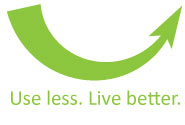Never doubt that a small group of thoughtful, committed people can change the world. Indeed, it is the only thing that ever has.
Margaret Mead
…but what if it were a large group?
The Power of Individual Action
Never underestimate the power of the consumer. We built up this consumer economy — and we can change it. It was consumer choice that forced the auto industry to retool for conservation, and it is consumer preference that is driving the local food movement and creating a market for green power.
As individuals, we can feel powerless in the face of climate change, dwindling oil supplies and economic uncertainty. On the contrary, we have the power to shift our economy onto a sustainable path.
Start with the Simple Stuff
There are loads of lists out that tell you the simple things to do (change your lightbulbs, check your tire pressure, plant a tree etc.). There’s no need to make it complicated. You really don’t need a list to tell you to turn off the taps and the lights — just use your head. Make conservation second nature.
When you are ready, or if there is a particular need you have, go deeper!
Deep Conservation
Deep conservation is when things really get interesting. This is where you begin to make changes that will improve your life as well as save money and/or the environment.
Step 1. Who am I?
The first question to ask is why you want to conserve. Which of the three basic types of conserver best describes your reasons to conserve:
| Conserver Type | Motivated by | |
|---|---|---|
| |
Green Angel | Saving the planet |
| |
Cost Conscious | Saving money |
| |
Personal Benefit | Living healthier and quality of life |
Your motives will help you choose the type of solution. You can, of course, be motivated by all three reasons — the sweet spot in conservation is when our choices improve our lives, save money, and help the planet all at the same time.
Step 2. Who do I want to be?
There are literally thousands of ways to conserve, and conservation solutions are as individual as we are. The trick is to focus on the areas where you want to improve and then find the solutions that best fit your goals. Here’s ten ways to conserve, and examples of actions you can take:
| Conservation Priority | Action | |
| 1. Help Nature | Protect or restore natural areas | |
| 2. Save Resources | Conserve water, land and other resources | |
| 3. Save Energy | Conserve energy | |
| 4. Use Green Power | Invest in renewable power | |
| 5. Drive Less | Find better ways to get around | |
| 6. Live local | Support local business and community | |
| 7. Eat Smart | Eat local and healthy foods | |
| 8. Buy Green | Support a green economy | |
| 9. Waste Less | Reduce, re-use and recycle; invest in durability | |
| 10. Prevent Pollution | Go toxic-free; dispose of hazards responsibly |
Step 3. What do I want to do?
Knowing your priorities, it becomes easier to pick the conserver solutions that make the most sense for you. If your are looking to save money, focus on energy conservation and transportation alternatives. If you want to invest in green solutions, then renewable energy and hybrid vehicles are a better option. And if you are want to get more out of life, get on a bike!
Obviously where you live will also determine what you can do. “Live local” might mean walking to the local store in an urban area, or it could mean growing your own food if you live in the country.
Step 4. Find help.
It used to be that if you wanted to live a green lifestyle, you were pretty much on your own. Nowadays, there are are all kinds of products, services and incentives to help you along the way.
There are also online resources and directories – Here’s one — the Great Green Directory — that was developed by the Conservation Council of Ontario with funding from the Ontario Ministry of the Environment. It is designed to help connect people with the products, services, incentives and other information that is available locally, provincially, and nationally. It’s a great start — and with a bit more sponsorship funding it would be an absolutely fantastic tool for connecting people with solutions.
 Use Less, live better
Use Less, live better
The key thing is to find solutions that make sense for you. If you don’t find value in conservation, you are not likely to keep doing it.
Remember, the goal is not to be perfect, only better.